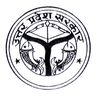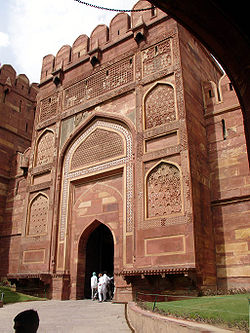Uttar Pradesh
| Uttar Pradesh उत्तर प्रदेश |
|||||
| Land of Ganga and Jamuna | |||||
| — state — | |||||
|
|||||
|
|
|||||
| Coordinates | |||||
| Country | |||||
| Region | Awadh, Baghelkhand, Braj, Bundelkhand, Purvanchal, RohilKhand, Indo-Gangetic Plain | ||||
| District(s) | 711 | ||||
| Uttar Pradesh | 14 November 18342 | ||||
| Capital | Lucknow | ||||
| Largest city | Kanpur | ||||
| Largest metro | Kanpur | ||||
| Governor | Banwari Lal Joshi | ||||
| Chief Minister | Kumari Mayawati | ||||
| Legislature (seats) | Bicameral (404 + 108=512) | ||||
| Parliamentary constituency | 80 (year 2004) | ||||
| High Court | Allahabad High Court | ||||
| District Courts of India | |||||
| Population • Density |
190,891,000[1] (1st) • 792 /km2 (2,051 /sq mi)[1] |
||||
| Sex ratio | 111.4 ♂/♀ | ||||
| Literacy • Male |
57.37% • 70.22% |
||||
| Official languages | Hindi, Urdu | ||||
|---|---|---|---|---|---|
| Time zone | IST (UTC+5:30) | ||||
| Area | 243286 km2 (93933 sq mi) | ||||
| Climate Temperature |
Cfa (Köppen) • 31 °C (88 °F) |
||||
| Governing body | Government of India, Government of Uttar Pradesh | ||||
|
Codes
|
|||||
| ISO 3166-2 | IN-UP | ||||
|
Footnotes
1 The decision to possibly create additional districts is pending.
2,[2][3][4] - 9 November 2000 : Uttaranchal state created from part of Uttar Pradesh. |
|||||
| Website | www.upgov.nic.in | ||||
Uttar Pradesh (Hindi: उत्तर प्रदेश, Punjabi: ਓਤਰ ਪ੍ਰਦੇਸ਼, Urdu: اتر پردیش), pronounced [ˈʊtːər prəˈdeːʃ] (![]() listen), "Northern Province"), often referred to as U.P., is a state located in the northern part of India. With a population of over 190 million people,[1] it is India's most populous state, as well as the world's most populous sub-national entity. Were it a nation in its own right, Uttar Pradesh would be the world's sixth most populous country.
listen), "Northern Province"), often referred to as U.P., is a state located in the northern part of India. With a population of over 190 million people,[1] it is India's most populous state, as well as the world's most populous sub-national entity. Were it a nation in its own right, Uttar Pradesh would be the world's sixth most populous country.
With an area of 93,933 sq mi (243,290 km2), Uttar Pradesh covers a large part of the highly fertile and densely populated upper Gangetic plain. It shares an international border with Nepal to the north along with the Indian state of Uttarakhand, Himachal Pradesh to the north-west, Haryana, Delhi and Rajasthan on the west, Madhya Pradesh on the south, Chhattisgarh and Jharkhand on the south east and Bihar on the east. The administrative and legislative capital of Uttar Pradesh is Lucknow and the financial and industrial capital is Kanpur. The state's high court is based at Allahabad with a bench in state capital Lucknow. It is home to many historical cities, including Allahabad, Varanasi and Agra. Kanpur is its largest city; other big cities are Gorakhpur, Meerut, Agra, Aligarh, Bareilly, Ghaziabad and Noida.
Uttar Pradesh has an important place in the culture of India; it is considered to be the birthplace of Hinduism, has been the ancient seat of Hindu religion, learning and culture, and has many important sites of Hindu pilgrimage. The State also has several sites important to Buddhism: the Chaukhandi Stupa marks the spot where Buddha met his first disciples, while the Dhamek Stupa in Sarnath commemorates Buddha's first sermon. Also the town of Kushinagar is where Gautama Buddha died.
Throughout its history, the region of Uttar Pradesh was sometimes divided between smaller kingdoms and at other times formed an important part of larger empires that arose on its east or west, including the Magadha, Nanda, Mauryan, Sunga, Kushan, Gurjara, Gupta, Pala and Mughal empires.
The Indo-Gangetic plain, that spans most of the state, is also the birth place of the Indo-Islamic syncretic culture of the medieval period. It holds much of the heritage of the Mughal Empire, including the world famous mausoleum Taj Mahal built by Shah Jehan, the magnificent tomb of Mughal Emperor Akbar the Great in Agra and Akbar's capital-palace in Fatehpur Sikri. It was a centre of nationalism during the British colonial period and has continued to play a prominent role in Indian political and cultural movements. The state has a rich heritage of traditional crafts and cottage industries of various types that employ highly skilled craftsmen and artisans.
Hindus constitute 80% of the population in the state. Islam is practised by about 18% of the population while the remaining 2% include Atheists, Sikhs, Jains, Buddhists and Christians, and also the tribal population.
Contents |
History
Evolution of the State
The area has undergone several name changes and territorial demarcations since the early 19th century, i.e., after the British East India Company had established its supremacy in the Gangetic plains. In 1833 the then Bengal Presidency of the Company was divided into two parts, one of which became Presidency of Agra; in 1836 the Agra area was named North-Western Provinces and placed under a Lieutenant Governor by the Company. In 1877, the two provinces of Agra and Oudh (Oudh was occupied by the Company, in 1858), were placed under one Colonial administrator of the British Crown; he was called Lieutenant Governor of the North-Western Provinces and Chief Commissioner of Oudh. In 1902 the name was changed to United Provinces of Agra and Oudh with Lieutenant Governor of the United Provinces of Agra and Oudh as administrator; in 1921 Lieutenant Governorship was elevated to Governorship and the name of the province was changed to United Provinces of British India. In 1935, the name was shortened to United Provinces. On independence from the British colonial rule in 1947, the princely states of Rampur, Banares and Tehri-Garwal were merged into the United Provinces. In 1950, the name of United Provinces was changed to Uttar Pradesh. In 1999 a separate Himalayan state, Uttaranchal, (now named Uttarakhand), was carved out of Uttar Pradesh.
Prehistory, legends and ancient period
Archeological finds in Uttar Pradesh confirm presence of Stone Age homo sapiens hunter-gatherers in Chhatarpalia, Mahugarh, Parisdhia, Lalitpur, Nihi and Gopipur,[5][6][7][8] between 85±11 and 72±8 kyr (thousand years ago) before present (BP); Middle Paleolithic and later the Upper Paleolithic artifacts dated at 21–31 kyr BP;[9] Mesolithic/Microlithic hunter-gatherer's settlement, near Pratapgarh, around 10550–9550 CE;[10] villages, domesticated cattle, sheep or goats and evidence of plants and agriculture as early as 6000 CE – although, most dates range between c. 4000 and 1500 CE – thus initiating a sequence which extends into the Iron Age,[11][12][13] beginning from Indus Valley Civilization and Harappa Culture finds in the Saharanpur division through the Vedic period.
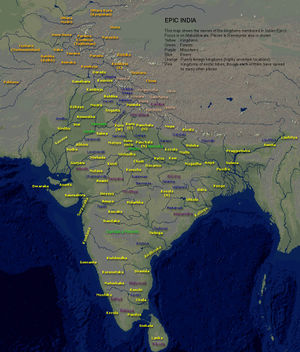
The known history of Uttar Pradesh goes back 4000 years, when the Aryans first made it their home in 2000 BCE; this heralded the Vedic age of the Indian civilization. The Aryans, infiltrating from their home-base in the present day Punjab region, had settled in the Doab region and the Ghagra plains, and called it with various names: Madhya Desha (Midland), Aryavarta (the Aryan land) and Bharatvarsha (the kingdom of Bharat, an important Aryan king). Early Indo-Aryan presence probably corresponds, in part, to the presence of Ochre Coloured Pottery in archaeological findings.[14]
The Aryans spread to other parts of the Indian subcontinent, reaching as far south as Kerala and Sri Lanka and, in due course, ancient kingdoms (Mahajanapadas) arose at several large population centres.
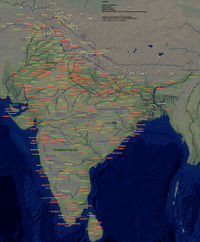
The ancient Mahajanapada era kingdom of Kosala in Ayodhya – where, according to Hindu legend, the divine king Rama of the Ramayana epic reigned – was located here. Krishna – another divine king of Hindu legend, who plays a key role in the Mahabharata epic and is revered as the eighth reincarnation (Avatara) of Hindu god Vishnu – was born in the city of Mathura. The aftermath of Mahabharata war is believed to have taken place in the area between the Doab region of Western Uttar Pradesh and Delhi, (in what was Kuru Mahajanapada), during the reign of the Pandava king Yudhishtira. The kingdom of the Kurus[15] corresponds to the Black and Red Ware and Painted Gray Ware culture and the beginning of the Iron Age in Northwestern India, around 1000 BCE. The revered Swaminarayan – mentioned in the Brahma Purana and Vishwaksena Samhita as the manifestation of God – was born in the village of Chhapaiya.
Most of the empire building invasions of North India, from the east as well as the west, passed through the vast swathe of Gangetic plains of what today is Uttar Pradesh. Control over this region was of vital importance to the power and stability of all of India's major empires, including the Mauryan (320–200 BCE), Kushan (100–250 CE) and Gupta (350–600 CE) Rajput (650–1036 CE) empires.
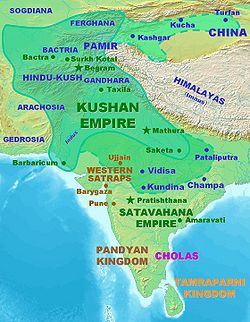
Following the Hun invasions that broke Guptas' empire, the Ganga-Yamuna Doab saw the rise of Kannauj. During the reign of Harshavardhana (590–647 CE), the Kannauj empire was at its zenith; spanning from Punjab and Gujarat to Bengal and Orissa – and parts of central India, north of the Narmada River – it encompassed the entire Indo-Gangetic plain. A patron of Buddhism and the University at Nalanda, Harsha organized theological debates and also patronised art and literature. A noted author on his own merit, he wrote three Sanskrit plays. Many communities in various parts of India boast of being descendants of migrants from Kannauj, reflecting its glory in the past.[16] Soon after Harshavardhana's death, his empire disintegrated into many kingdoms, to be invaded and ruled mostly by Rajputs, who also challenged Bengal's mighty Pala Empire's control of the region.
Medieval

The fall of the post-Harshavardhana Rajput kings of north India came when the Turko-Afghan Muslim rulers moved into present day Uttar Pradesh. Much of the state formed part of the various Indo-Islamic empires (Sultanates) after 1000 CE and was ruled from their capital, Delhi.
Later, in Mughal times, U.P. became the heartland of their vast empire; they called the place 'Hindustan', which is used to this day as the name for India in several languages. Agra and Fatehpur Sikri were the capital cities of Akbar, the great Mughal Emperor of India. At their zenith, during the rule of Aurangzeb, the Mughal Empire covered almost the entire Indian subcontinent (including present day Afghanistan, Pakistan and Bangladesh), which was ruled at different times from Delhi, Agra and Allahabad.
When the Mughal Empire disintegrated, their last territory remained confined to the Doab region of Hindustan and Delhi. Other areas of Hindustan (U.P.) were now ruled by different rulers: Oudh was ruled by the Nawabs of Oudh, Rohilkhand by Afghans, Bundelkhand by the Marathas and Benaras by its own king, while Nepal controlled Kumaon-Garhwal as a part of Greater Nepal. The state's capital city of Lucknow was established by the Muslim Nawabs of Oudh in the 18th century.
Modern-colonial
Starting from Bengal in the later half of the 18th century, a series of battles for North Indian lands finally gave the British East India Company accession over this state's territories – including the territories of Bundelkhand, Kumaon and Benaras rulers – and the last Mughal territories of Doab and Delhi. When the Company included Ajmer and Jaipur kingdoms in this northern territory, they named it the "North-Western Provinces" (of Agra). Today, the area may seem large compared to several of the Republic of India's present 'mini-states' – no more than the size of earlier 'divisions' of the British era – but at the time it was one of the smallest British provinces. Its capital shifted twice between Agra and Allahabad.
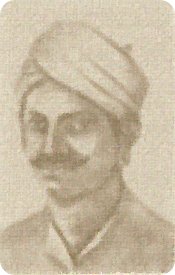
Due to dissatisfaction with British rule, a serious rebellion erupted in various parts of North India; Meerut cantonment's sepoy, Mangal Pandey, is widely credited as its starting point. It came to be known as the Indian Rebellion of 1857. After the revolt failed the British, in an attempt to divide the most rebellious regions, split the Delhi region from ‘NWFP of Agra’ and merged it with Punjab, while the Ajmer- Marwar region was merged with Rajputana and Oudh was incorporated into the state. The new state was called the 'North Western Provinces of Agra and Oudh', which in 1902 was renamed as the United Provinces of Agra and Oudh. It was commonly referred to as the United Provinces or its acronym UP.
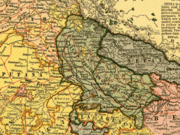
In 1920, the capital of the province was shifted from Allahabad to Lucknow. The high court continued to be at Allahabad, but a bench was established at Lucknow. Allahabad continues to be an important administrative base of today's Uttar Pradesh and has several administrative headquarters.
Uttar Pradesh continued to be central to Indian politics and was especially important in modern Indian history as a hotbed of both the Indian Independence Movement and the Pakistan Movement. Nationally known figures such as Jawaharlal Nehru were among the leaders of the movement in UP. The All India Kisan Sabha (AIKS) was formed at the Lucknow session of the Indian National Congress on 11 April 1936 with the legendary nationalist Swami Sahajanand Saraswati elected as its first President,[17] in order to address the long standing grievances of the peasantry and mobilise them against the zamindari landlords' attacks on their occupancy rights, thus sparking the Farmers' movement in India.[18][19]
Post-independence
After independence, the state was renamed Uttar Pradesh ("northern province") by its first chief minister, Govind Ballabh Pant. Pant was well acquainted with and close to Jawaharlal Nehru (the first Prime Minister of free India) and was also popular in the Congress Party. He established such a good reputation in Lucknow that Nehru called him to Delhi, the capital and seat of Central Government of the country, to make him Home Minister of India in 27 December 1954. He was succeeded by Dr. Sampoornanand, a classicist Sanskrit scholar. Following a political crisis in Uttar Pradesh, initiated by Kamlapati Tripathi and C.B.Gupta, Sampurnanand was asked to resign as CM in 1960 and sent to Rajasthan as the Governor of Rajasthan, paving the way for Gupta and Tripathi to become Chief Ministers.
Sucheta Kripalani served as India's first woman chief minister from October 1963 until March 1967, when a two-month long strike by state employees caused her to step down. After her, Chandra Bhanu Gupta assumed the office of Chief Minister with Laxmi Raman Acharya as Finance Minister, but the government lasted for only two years due to the confusion and chaos which ended only with the defection of Charan Singh from the Congress with a small set of legislators. He set up a party called the Jana Congress, which formed the first non-Congress government in U.P. and ruled for over a year.
Hemvati Nandan Bahuguna was chief minister for Congress Party government for part of the 1970s. He was dismissed by the Central Government headed by Indira Gandhi, along with several other non-Congress chief ministers, shortly after the imposition of the widely unpopular Emergency, when Narain Dutt Tewari – later chief minister of Uttarakhand – became chief minister. The Congress Party lost heavily in 1977 elections, following the lifting of the Emergency, but romped back to power in 1980, when Mrs. Gandhi handpicked the man who would later become her son's principal opposition, V.P. Singh, to become Chief Minister. On 9 November 2000, the Himalayan portion of the state, comprising the Garhwal and Kumaon divisions and Haridwar district, was formed into a new state, now called Uttarakhand, meaning the 'Northern Segment' state.
Geography
Uttar Pradesh shares an international border with Nepal and is bounded by the Indian states of Uttarakhand, Himachal Pradesh, Haryana, Delhi, Rajasthan, Madhya Pradesh, Chhattisgarh, Jharkhand and Bihar. The state can be divided into two distinct hypsographical regions.
The larger Gangetic Plain region is in the north: it includes the Ganga-Yamuna Doab, the Ghaghra plains, the Ganga plains and the Terai. It has highly fertile alluvial soils and flat topography (slope 2 m/km) broken by numerous ponds, lakes and rivers.
The smaller Vindhya Hills and Plateau region is in the south: it is characterised by hard rock strata and varied topography of hills, plains, valleys and plateau; limited availability of water makes the region relatively arid.
Flora and fauna
Uttar Pradesh has 12.8% land under forest cover now. In spite of alarming deforestation and poaching of wild life, a diverse flora and fauna exists. Several species of trees, large and small mammals, reptiles and insects are found in the belt of temperate upper mountainous forests; medicinal plants are also found wild here, or are now grown on plantations. Terai-Duar savanna and grasslands support cattle. Moist deciduous trees grow in the upper Gangetic plain, including its riverbanks. In fact, this vast plain is so fertile and life supporting that any thing, which can live or grow anywhere, will do so here. Ganges and its tributaries are the habitat of a variety of large and small reptiles, amphibians, fresh-water fish and crabs. Mostly scrubs, trees like babool and animals like chinkara are found in the arid Vindhyas.[20][21] The state’s important plants and animals include the following:
Trees: pine, rhododendrons, silver fir, deodar, saal, oak, teak, sheesham, mango, neem, banyan, peepal, imli, jamun, mahua, semal, gular and dhak.
Medicinal plants: hingan,[22] Dhak,[23] rauwolfia, sepentina, hexandrum, podophyllum.
Large vertebrates: elephant, tiger, bear, neelgai, wild pig, deer, wolf, jackal, fox, languor, porcupine.
Birds: peacock, gray quail, pigeon, swallow, maina, Indian parakeet, crow and duck.
Reptiles: crocodile, gharial, goh, snakes, chameleon and other lizards.
Fish: Rohu, catla, khusa, parhan, patra, moi, korouch and singhi.
According to Hindu legend, Lord Rama’s warrior devotee Hanuman had brought life saving Sanjivani herbs from a mountain of this, or possibly the breakaway Uttarakhand, region.
Climate
The climate of Uttar Pradesh is predominantly subtropical, but weather conditions change significantly with location and seasons:
Temperature: Depending on the elevation, the average temperatures vary from 12.5–17.5 °C (55–64 °F) in January to 27.5–32.5 °C (82–91 °F) in May and June. The highest temperature recorded in the State was 49.9 °C (121.8 °F) at Gonda on 8 May 1958.
Rainfall: Rainfall in the State ranges from 1,000–2,000 mm (39–79 in) in the east to 600–1,000 mm (24–39 in) in the west. About 90% of the rainfall occurs during the southwest Monsoon, lasting from about June to September. With most of the rainfall concentrated during this four-month period, floods are a recurring problem and cause heavy damage to crops, life, and property, particularly in the eastern part of the state, where the Himalayan-origin rivers flow with a very low north-south gradient.
Snowfall: In the Himalayan region of the State, annual snowfall averaging 3 to 5 metres (10 to 15 feet) is common between December and March.
Droughts: Periodic failure of monsoons results in drought conditions and crop failure.
| Climate data for Uttar Pradesh, India | |||||||||||||
|---|---|---|---|---|---|---|---|---|---|---|---|---|---|
| Month | Jan | Feb | Mar | Apr | May | Jun | Jul | Aug | Sep | Oct | Nov | Dec | Year |
| Average high °C | 11 | 18 | 28 | 36 | 41 | 37 | 38 | 33 | 31 | 26 | 17 | 14 | 27.5 |
| Average low °C | 3 | 11 | 15 | 22 | 26 | 27 | 27 | 26 | 24 | 19 | 19 | 7 | 18.8 |
| Average high °F | 52 | 64 | 83 | 96 | 106 | 99 | 100 | 91 | 88 | 79 | 62 | 57 | 81.4 |
| Average low °F | 37 | 51 | 59 | 72 | 79 | 81 | 80 | 79 | 76 | 67 | 56 | 44 | 65.1 |
| Source: www.wunderground.com[24] | |||||||||||||
Constituent regions
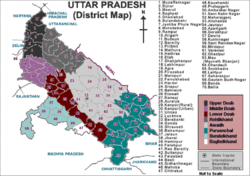
The state comprises several distinct regions:
- The Doab region which runs along UP’s western border from north to south; this region is further divided into three zones:
- The Upper Doab in the north-west,
- The Middle Doab in the west,
- including the Braj-bhumi in the trans-Yamuna area,
- The Lower Doab in the south-centre,
- The Rohilkhand region in the north;
- The Awadh(or Oudh), the historic country of Kosalas in the centre;
- The northern parts of Bundelkhand in the south;
- The northern parts of Bagelkhand in the south-east; and
- The south-estern part of the Bhojpur country in the east, commonly called Purvanchal ("Eastern Province").
Administrative divisions and districts (as in 2010)
The state of Uttar Pradesh consists of seventy two districts, which are grouped into eighteen divisions:-
Agra Division, Aligarh Division, Allahabad Division, Azamgarh Division, Bareilly Division, Basti Division, Chitrakoot Division, Devipatan Division, Faizabad Division, Gorakhpur Division, Jhansi Division, Kanpur Division, Lucknow Division, Meerut Division, Mirzapur Division, Moradabad Division, Saharanpur Division and Varanasi Division.
The largest district in terms of area is Lakhimpur Kheri. The largest district in terms of population is Allahabad, followed by Kanpur Nagar (Census 2001).The largest city(URBAN Area) is Kanpur Nagar.
Major cities
Municipal Corporations
- Agra
- Aligarh
- Allahabad
- Bareilly
- Ghaziabad
- Gorakhpur
- Jhansi
- Kanpur
- Lucknow
- Meerut
- Moradabad
- Saharanpur
- Varanasi
Special Status
Other Big Urban Centres
- Mathura
- Muzaffarnagar
- Shahjahanpur
- Firozabad
- Etawah
- Budaun
- Rampur
- Faizabad
- Farrukhabad
Demographics
| Population Growth | |||
|---|---|---|---|
| Census | Pop. | %± | |
| 1951 | 60,274,000 |
|
|
| 1961 | 70,144,000 | 16.4% | |
| 1971 | 83,849,000 | 19.5% | |
| 1981 | 105,137,000 | 25.4% | |
| 1991 | 132,062,000 | 25.6% | |
| 2001 | 166,198,000 | 25.8% | |
| Source:Census of India[25] | |||
Uttar Pradesh is the most populous state in India with a population of over 190 million people as of 1 July 2008. If it were a separate country, Uttar Pradesh would be the world's fifth most populous nation, next only to China, India, the United States of America and Indonesia. As of the 2001 census of India, about 77% of Uttar Pradesh population is Hindu, while Muslims make up around 20% of the population. The remaining population consists of Sikhs, Buddhists, Christians and Jains.[26]
The population of Uttar Pradesh is divided into numerous castes and sub-castes. Historically, Hindu society is divided into four sub-divisions or varnas, the Brahmins, Kshatriyas, Vaishyas and Shudras, with a further fifth group which was considered to be outside the caste system, and are now known as Dalit.
The peripheral regions of Uttar Pradesh, are home to a number of tribal communities such as Agaria, Baiga, Bhar, Bhoksa, Bind, Chero, Gond, Kol and Korwa. Five of these tribal communities have been recoginised by the Government of India as disadvantaged scheduled tribes, viz. Tharus, Boksas, Bhotias, Jaunswaris and Rajis.[27]
Politics

The State Assembly (Vidhan Sabha) has 403 electoral constituencies. In the Uttar Pradesh Elections, 2007, Mayawati's Bahujan Samaj Party achieved unexpected majority status, leading to her emergence as the chief minister of Uttar Pradesh. This is the first time, since 1991 victory of the Bharatiya Janata Party (BJP) with a majority, that a single party has gained absolute majority; the last two decades having been mostly dominated by various coalitions among the Samajwadi Party, Bharatiya Janata Party, and the Bahujan Samaj Party. One characteristic of the BSP win in 2007 was the amalgamation of Brahmin votes into this Dalit dominated party,[28] as opposed to the decades-old trend of deep-rooted electoral divisions in the state between Dalits, Upper Castes, Muslims and different OBC groups, which tend to vote in blocks. Mayawati, having won 206 seats, took the oath of secrecy for the post of UP's next CM on 13 May 2007. She became Chief Minister for the fourth time. Along with her 19 cabinet rank ministers, 21 Ministers of State holding Independent Charge were also sworn in by the Governor T. V. Rajeswar. Some of the prominent names of her cabinet colleagues are: Awadhpal Singh, Babu Singh Kushwaha, Badshah Singh, Nasimuddin Siddiqui, Rakesh Dhar Tripathi, Ratanlal Ahirwar and Sudhir Goyal. Former Chief Minister Mulayam Singh Yadav's Samajwadi Party stood second in State with 97 seats.
Political leadership
The state has a record of providing national leadership; eight of India's fourteen Prime Minister's were from Uttar Pradesh. They are: Jawaharlal Nehru, Lal Bahadur Shastri, Indira Gandhi, Rajiv Gandhi, Choudhary Charan Singh, Vishwanath Pratap Singh, Chandra Shekhar and Atal Behari Vajpayee, who represented a UP constituency, though he was born in Gwalior.
The contemporary political scene is also interesting in the national context. Heirs-apparent to the Nehru-Gandhi family have adopted U.P. as their home state. Congress President Sonia Gandhi represents Rae Bareli and her son Rahul Gandhi Amethi, Sultanpur. Indira Gandhi's younger daughter-in-law Maneka Gandhi is a seven time BJP Parliamentarian from Aonla, while her son Varun Gandhi has also made his debut as a BJP politician and is a member of Lok Sabha from Pilibhit. Other prominent politicians include BJP leader and past Human Resources Development minister Dr. Murli Manohar Joshi, SP leader and ex-Chief Minister Mulayam Singh Yadav, BSP leader and now fourth time Chief Minister Mayawati, BJP President and ex-Chief Minister Rajnath Singh, former BJP Chief Minister Kalyan Singh , Rashtriya Lok Dal chief Ajit Singh and ex-Chief Minister of Uttar Pradesh and later of Uttarakhand, Narayan Dutt Tiwari, Ex-Minister for State for Environment & Forest, & also Minister for Education [Vir Sen, Khurja & Hapur], Mukhtar Abbas Naqvi Ex Information & Broadcasting Minister, Govt. of India, Zafar Ali Naqvi Minister of Education, UP Govt. etc.
At the lowest tier of political pyramid the state has a large number of village councils, known as Panchayats, which are similar to those found in other states in India.
Education
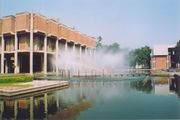
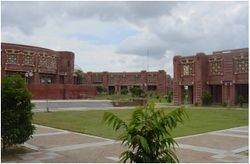

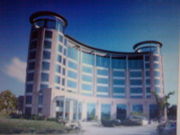
The region of Uttar Pradesh had a long tradition of learning, although it had remained mostly confined to the elite class and the religious establishment. Sanskrit-based education comprising the learning of Vedic-to-Gupta periods, coupled with the later Pali corpus of knowledge and a vast store of ancient-to-medieval learning in Persian/Arabic languages, had formed the core of Hindu-Buddhist-Muslim education, until the rise of British power. The present schools-to-university system of education owes its inception and development here, as in the rest of the country, to foreign Christian missionaries and the British colonial administration.
Aligarh Muslim University is a residential academic institution. Modelled on the British University of Cambridge, it was established by Sir Syed Ahmed Khan in 1875 – then named as Mohammedan Anglo-Oriental College – and in 1920 it was granted the status of a Central University by an Act of Indian Parliament. Located in the city of Aligarh, Uttar Pradesh, India, it was among the first institutions of higher learning set up during the British Raj.
Banaras Hindu University is a Central University located in Varanasi.[29] It evolved out of the Central Hindu College of Varanasi, set up by Annie Besant – a colourful British lady of Irish descent – who joined hands with Pandit Madan Mohan Malaviya in April 1911 for a common Hindu University at Varanasi. Eventually, the Banaras Hindu University started functioning from 1 October 1917, with the Central Hindu College as its first constituent college. Most of the money for the university came from Hindu princes and its present 1,350-acre (5.5 km2) campus was built on land donated by the Kashi Naresh. Regarded as the one among the largest residential universities in Asia,[30] it has more than 128 independent teaching departments; several of its colleges – including science, linguistics, law, engineering (IT-BHU) and medicine (IMS-BHU) – are ranked amongst the best in India.[31] The university's total enrollment stands at just over 15000, including the students from abroad. It will be the only university in India that will host one of the IITs in its premises, the IT-BHU, from academic session 2010.[32]
The school of Management Sciences (SMS), Varanasi is an autonomous educational institution approved by All India Council for Technical Education (AICTE), Ministry of HRD , Govt of India. It was established in 1995, by SMS Society, A philonthrphic non profit organization registered under Societies Registration Act 1860.
The Indian Institute of Technology Kanpur – set up in 1960 in the industrial city of Kanpur and now known as IIT-Kanpur or 'IITK' – is one of the famous internationally respected Indian Institutes of Technology; it is primarily focused on teaching of undergraduates in engineering and related sciences and technologies and research in these fields. The Indian Institute of Management Lucknow is among premier management schools in India. There are many other reputed schools in the State's capital Lucknow, including the famous Loreto Convent and its sister institution, St Agnes' Loreto High School, La Martinière College, CMS.
Uttar Pradesh Government is constantly working on promoting education in the state. The Government has given permission to many new Universities in the state. Among them is Noida University.
Economy
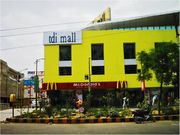
Uttar Pradesh is the second largest state-economy in India contributing 8.17% to India's total GDP. Between 2004 and 2009, Uttar Pradesh grew at 6.29% and is now quite close to the miracle growth norm (which is 7% by international norm).[33] Most of the part of this growth was contributed in period of 2007-09 after Mayawati took the charge of Uttar Pradesh. She decided to promote the Lucknow as another IT destination after Noida. Some IT giants like TCS have already started their campus in Lucknow since 2008-09.
The major economic activity in the state is agriculture; in 1991, 73% of the population in the state was engaged in agriculture and 46% of the state income was accounted for by agriculture. UP has retained its preeminent position in the country as a food-surplus state.
Uttar Pradesh is home to largest number of Small Scale industrial units in the country, with 12% of over 2.3 million units.[34] But, industrial output has been adversely affected by erratic power supply from the UP State Electricity Board and remains far below its full production capacity. Unavailability of adequate raw materials at competitive prices is another negative factor. Also, like in most parts of India, traders and middlemen make most of the profits while the labour class lives at subsistence level. Nevertheless, labour efficiency is higher in UP at 26 than the national average of 25.[34]
Kanpur is the largest economic hub of Uttar Pradesh with a solid GDP of 20 billion $ followed by Lucknow that is why it is assigned the status of Economic capital of Uttar Pradesh. With a GDP of 20 billion $ Kanpur stands in Top 10 Indian cities the only city of Uttar Pradesh. Following are some of the important industrial hubs in the state:
Kanpur is the largest shoe-manufacturing centre in the country.
NOIDA and Lucknow are among the top IT (Information Technology) destinations of the country.
Meerut, a manufacturing centre of sports goods, sharp tools like scissors and also of gold ornaments, is regularly listed among the top tax-paying cities in the country.[35]
Mirzapur and Bhadohi are manufacturing centres and worldwide exporters of carpets and cotton durries.
Moradabad, a famous production centre of traditional 'Moradabadi' metalware, has emerged now as a major producer and exporter of stainless steel utensils also.
Aligarh is a manufacturing hub of brass, zinc, aluminium, iron door fittings and is also famous for its padlocks. These items are exported all over the world.
Agra was visited by more than 8 million domestic and 825,000 foreign tourists in 2006, followed by Varanasi, Lucknow, Allahabad, Vrindaban and Mathura.
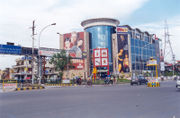
Economy is gearing itself to cater to contemporary Western tastes and life style in upper class Uttar Pradeshis; elegant shopping malls are coming up in big cities to satisfy their needs. The economy also benefits from the State's thriving tourism industry.
Tourism
Uttar Pradesh attracts a large number of visitors, both national and international; with more than 71 million domestic tourists (in 2003) and almost 25% of the All-India foreign tourists visiting Uttar Pradesh, it is one of the top tourist destinations in India.[34] There are two regions in the state where a majority of the tourists go, viz. the Agra circuit and the Hindu pilgrimage circuit.
The city of Agra, gives access to three World Heritage Sites: Taj Mahal, Agra Fort and the nearby Fatehpur Sikri. Taj Mahal is a mausoleum built by Mughal Emperor Shah Jahan in memory of his beloved wife, Mumtaz Mahal. It is cited as "the jewel of Muslim art in India and one of the universally admired masterpieces of the world's heritage". Agra Fort is about 2.5 km northwest of its much more famous sister monument, the Taj Mahal. The fort can be more accurately described as a walled palatial city. Fatehpur Sikri was the world famous 16th century capital city near Agra, built by the Mughal emperor Akbar the Great, whose mausoleum in Agra is also worth a visit. Dayal Bagh in Agra is a modern day temple and popular tourist sight. Its lifelike sculptures in marble are unique in India. Agra's dubious modern attractions include Asia's largest Spa as well as Asia's first and only 6D theatre.
The pilgrimage circuit includes the holiest of the Hindu holy cities on the banks of sacred rivers Ganga and the Yamuna: Varanasi (also considered world's oldest city), Ayodhya (birth place of Lord Rama), Mathura (birth place of Lord Krishna), Vrindavan (the village where Lord Krishna spent his childhood), and Allahabad (the confluence or 'holy-sangam' of the sacred Ganga-Yamuna rivers).
Varanasi is widely considered to be one of the oldest cities in the world. It is famous for its ghats (bathing steps along the river), full of pilgrims year round who come to bathe in the sacred Ganges River.
Mathura is world-famous for its colourful celebrations of the Holi festival, which attracts many tourists also – thanks partly to the hype, which the Indian film industry has given to this highly entertaining socio-religious festival.
Thousands gather at Allahabad to take part in the Magh Mela festival, which is held on the banks of the Ganges. This festival is organised on a larger scale every 12th year and is called the Kumbha Mela, where over 10 million Hindu pilgrims congregate — One of proclaimed the largest gathering of human beings in the world.
The historically important towns of Sarnath and Kushinagar are located not far from Varanasi. Gautama Buddha gave his first sermon at Sarnath after his enlightenment and died at Kushinagar; both are important pilgrimage sites for Buddhists. Also at Sarnath are the Pillars of Ashoka and the Lion Capital of Ashoka, both important archaeological artifacts with national significance. At a distance of 80 km from Varanasi, Ghazipur is famous not only for its Ganga Ghats but also for the Tomb of British potentate Lord Cornwallis, maintained by the Archeological Survey of India.
Lucknow, the capital of Uttar Pradesh, has several beautiful historical monuments such as Bara Imambara and Chhota Imambara. It has also preserved the damaged complex of the Oudh-period British Resident's quarters, which are being restored.
Some of the main natuaral protected areas in Uttar Prdesh are:-
- Dudhwa National Park is one of the best tiger reserves in the country.
- Pilibhit Tiger Reserve – home to the Tiger Reserve.
- Katarniaghat Wildlife Sanctuary – the most concentrated sanctuary in India with a large population of tigers as well as leopards – situated in Bahraich and bordering Nepal is also worth a visit.
Some areas require a special permit for non-Indians to visit.
|
JK temple, a beautiful temple built by J.K.Trust in the industrial city of Kanpur |
Kumbh Mela, is the largest gathering anywhere in the world. |
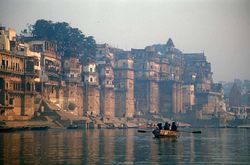 Varanasi is a holy city for Hinduism and Buddhism |
|
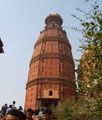 Madan Mohan temple in Brindavan. |
 The Tomb of Salim Chisti |
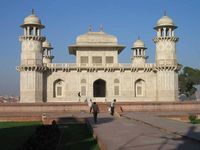 Itmad-Ud-Daulah's Tomb at Agra |
|
 The five-storey Panch Mahal at Fatehpur Sikri |
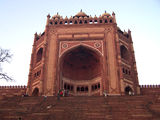 Buland Darwaza |
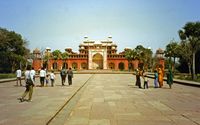 Tomb of Akbar the Great |
Gateway to Bara Imambara |
|
The Chhota Imambara |
 The Dhamekh Stupa is located in Sarnath where Gautama Buddha first taught the Dharma |
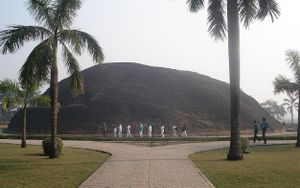 Kushinagar is a town where Gautama Buddha died |
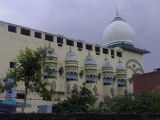 Kakrala is town where Sufi Hazrat Shah Sharafat Miyan was Born. |
Transportation
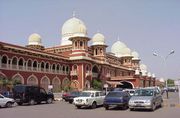
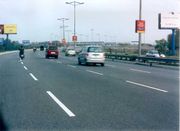
The state has a large network of multimodal transportation system:
Airways: The state has four major airports and 23 airstrips. Cities that have nationally well connected. Domestic airports are Lucknow, Agra, Kanpur Allahabad and Varanasi. Lucknow is the largest and most important airport of the state. Also, Lucknow and Varanasi are two International Airports situated in state. Bareilly's Trishul Air-base will soon serve also as a domestic airport.
Railways: Almost all the major as well as smaller cities of the state are linked through railways. It has largest railway network in the country; with a total length of 8,546 km (as on 2006) and the sixth largest railway density.
Roadways: The state has largest road network in the country, after Maharashtra. It boasts of 31 National Highways (NH), with a total length of 4,942 km (8.5% of total NH length in India). It has seventh highest road density in India, (1,027 km per 1000 km,2 as on 2002 ) and largest surfaced urban road network in the country (50,721 km, as on 2002). Cities of Kanpur, Lucknow, Bareilly, Allahabad, Varanasi, Jhansi, Gorakhpur, Agra and Ghazipur are connected to a number of National Highways. With an existing expressway between Lucknow and Kanpur, new expressways are coming up between Agra and Noida and between Noida and Ballia (near Ghazipur). The State Government’s road transport company Uttar Pradesh State Road Transport Corporation (UPSRTC) serves nationalized routes in the state for intrastate and interstate transport.
Waterways: A long stretch of the river Ganges – from Allahabad (Uttar Pradesh) to Haldia (West Bengal) – has been declared as National Waterway (NW)-I and 600 km of the total NW-I lies in Uttar Pradesh.
Although, the state has a large and diversified transportation network, its condition and functioning need substantial improvement.
Culture
Architecture
Architectural legacies of the past millennia of Uttar Pradesh survive to varying extent. The oldest of them fall within the purview of archeology or mythology; religious places in the State – identifiable in the narratives of Puranas and other sacred literature of Indian religions – have architectural edifices that are very old and have been built over repeatedly in course of time.
Medieval kings and emperors have left imposing monuments: forts, palaces, temples, mosques and mausoleums, whose external and internal grandeur recalls the opulence of those times. British colonial architecture is still seen in many cities' judicial buildings, hospitals, banks, post offices, police stations, and railway stations.
- there are three industries they are cotton metal and leather
Art and craft
Uttar Pradesh is famous for its rich heritage of art and craft. Most famous centres are the following:
Bareilly boasts for its Zari work, (a type of fabric decoration), Surma (Kohl) and intricate ear-rings or ear-pendants called 'Jhumka'.
Firozabad, the city of bangles, is also a hub for crafting many glass accessories. The glass artifacts produced in its factories are of high value and are exported all over the country and around the world.
Kannauj is well known for oriental perfumes, scents and rose water and also for traditional tobacco products.
Kanpur is internationally known for its leather craft; shoes and other leather items are made here for the Indian market and exported to foreign countries as well.Kanpur is also known as Leather City of the World.
Khurja is famous for its ceramics pottery; in fact, the entire state is famous for its pottery not only in India but also around the world.
Lucknow, the capital, boasts of its cloth work and embroidery (chikan) work on silk and cotton garments.
Allahabad is Known for his National Institute of Art & craft College.
Bhadohi is known for carpets and also known as dollar-city; beside this, it is one of the highest revenue generating districts of UP.
Moradabad is well known for its metal-ware, especially brass artifacts.
Pilibhit is known for its wooden footwear (locally called Paduka or Khadaon) and also for flutes made of wooden pipes. Flutes are exported to Europe, America and other countries.
Saharanpur is known all over India and abroad for its wood-carving items produced there.
Varanasi is famous for its Banarasi saris and silk. A banarasi sari is an essential part of any marriage in the state.
Language and literature
Uttar Pradesh is often referred to as the 'Hindi heartland of India'.[36] While the languages of state administration are Hindi,[37] established by the Uttar Pradesh Official Language Act, 1951, and Urdu, established by the Amendment to the same in 1989, the native languages of the state are considered as dialects of Hindi, both by the common populace as well as the State and Central Governmental authorities. Linguistically, the state spreads across the Central, East-Central and Eastern zones of the Indo-Aryan languages, the major native languages of the state being, Awadhi, Bundeli, Braj Bhasha, Kannauji and the vernacular form of Khari boli, which also forms the basis for the standardised Hindi and Urdu registers. Bagheli is spoken on the southwestern fringes of the state.[38] The state government promotes the native dialects in cultural festivals[39] – education in the dialects, however, is negligible. Moreover, the literature of the two main literary dialects of the medieval era, Braj Bhasha and Awadhi, is considered to be subsumed under Hindi literature. While once these two dialects were the main literary vehicles in the region, any progress in literature in them or any of the other native languages is negligible.
Dance and music

The state is home to a very ancient tradition in dance and music. During the eras of Guptas and Harsh Vardhan, Uttar Pradesh was a major centre for musical innovation. Swami Haridas was a great saint-musician who championed Hindustani classical music. Tansen, the great musician in Mughal Emperor Akbar's court, was a disciple of Swami Haridas. The ragas sung by Tansen were believed to be so powerful that they could bring rain, or light a fire, when recited.
Kathak, a classical dance form, involving gracefully coordinated movements of feet and arms along with the entire body, grew and flourished in Uttar Pradesh. Wajid Ali Shah, the last Nawab of Awadh, was a great patron and a passionate champion of Kathak. Today, the state is home to two prominent schools of this dance form, namely, Lucknow Gharana and Banaras Gharana.
In modern times, Uttar Pradesh has given to the world music legends like Anup Jalota, Baba Sehgal, Girija Devi, Gopal Shankar Misra, Hari Prasad Chaurasia, Kishan Maharaj, Naushad Ali, Pandit Ravi Shankar, Shubha Mudgal, Siddheshwari Devi, Talat Mehmood, and Ustad Bismillah Khan. The legendary Ghazal singer Begum Akhtar was also a native of Uttar Pradesh; "Ae Mohabbat Tere anjaam pe rona aaya" is said to be one of her best musical performances of all times. Uttar Pradesh is also the birthplace of British pop legend Sir Cliff Richard. The Bhatkhande Music Institute University at Lucknow is named after the great musician Pandit Vishnu Narayan Bhatkhande.
The region's folk heritage includes songs called rasiya (known and especially popular in Braj), which celebrate the divine love of Radha and Shri Krishna. These songs are accompanied by large drums known as bumb and are performed at many festivals. Other folk dances or folk theater forms include:
- Khayal
- Naqal – (mimicry)
- Nautanki
- Qawwali
- Raslila
- Swang
- Ramlila, which includes enacting the entire Ramayana.
Lokrang Sanskritik Samiti – an organisation of Jogia Janubi Patti, Fazilanagar, Kushinagar – is doing research work in the field of Folk-songs, Folk-artists and Folk-cultures. In the month of May, every year the Samiti organises its function "Lokrang". More than 150 artists and writers participate in this programme.
Cuisine
Uttar Pradesh has a rich tradition of sumptuous vegetarian and non-vegetarian food preparations and of sweetmeats, seen at their best on formal occasions.
A formal vegetarian meal of Uttar Pradesh consists of chapatis, rotis (flatbread) and/or puris (deep fried puffed flatbreads), daal (thick lentil soup), rice (boiled white rice), vegetable curries (one or more of dry/fried and semi-liquid curries each), curd, pickles, papad (thin spicy crackers) and a variety of sweets ( gulab jamuns ,rasmalai ,rabri,jalebi ,laddoos of varying varieties ,pethas ,kheer ,gujhiys and many others). It is normally served in metal dishes and traditionally eaten without the use of cutlery, sitting on the bare floor. When a large gathering is to be feasted in a traditional manner, food may also be served on disposable, flat platters (called 'pattal'), which are made by intertwining broad leaves of certain trees.Samosas and pakoras are among the favourite snacks.
A non-vegetarian meal consists of many varieties of meat- or rice-preparations that have evolved in the region, and are now nationally and internationally known as the Moghlai cuisine; some of these are: kebab, kofta, korma, keema, pulao, biryani, parathas (plain or stuffed), halwa, firni etc. In addition, a selection from the above vegetarian dishes may be present among the food spread. Traditionally, food is served in metal-ware or ceramic crockery, eaten directly with bare hands or (sometimes) with spoons, sitting on the ground covered with a flooring material like cloth-sheet or carpet.
Dress
The people of Uttar Pradesh wear a variety of native- and Western-style dress. Traditional styles of dress include colourful draped garments, such as sari for women and dhoti or lungi for men, and stitched clothes, such as salwar kameez for women and kurta-pyjama for men. European-style trousers and shirts are also common among the educated men.
Dress material is chosen as per the need of the weather; hence, fabrics made of cotton and cotton-synthetic blends are common in summer and warm clothing, made of wool or synthetic-wool, is needed in winter, when a sweater, jacket and/or a coat may be worn, specially during peak winter.
Festivals
Religious practices are as much an integral part of everyday life, and a very public affair, as they are in the rest of India. Therefore, not surprisingly, many festivals are religious in origin, although several of them are celebrated irrespective of caste and creed.
Among the most important Hindu festivals are Diwali, Holi and Dashehra, which are also observed with equal fervour by Jains and Sikhs.Ten days of Ramlila takes place during the period of navratri and on the 10th day, epithet of Raavan is burnt with great fervour. Durga puja is also observed in many parts of the state during navratri. Bāra Wafāṭ, Eid, Bakreed and Birthdate of Imam Ali ibn Abitalib are recognized official Muslim religious festivals. Moharram, though the day of Ashura is official holiday but Shiites consider it as a day of mourning and not a festival as some people believe. Mahavir Jayanti is celebrated by Jains, Buddha Jayanti by Buddhists, Guru Nanak Jayanti by Sikhs and Christmas by the Christians.[40] Other festivals include Ram navami, Chhath puja, Krishna-janmashtami, Mahashivratri,etc.
Media
Uttar Pradesh is well integrated into the national media network:
Radio broadcasts: Broadcasting was started in India in 1936 by All India Radio (abbreviated as AIR), now officially known as Akashvani.[41] Today, it is the sister service of Doordarshan, the national television broadcaster; both are a division of Prasar Bharati (Broadcasting Corporation of India), an autonomous corporation of the Ministry of Information and Broadcasting, Government of India. Broadcasts in several languages are being aired in the State from a number of transmission stations by Akashwani.
Television: Telecasting had begun in India in 1959, with test educational telecasting in New Delhi. Doordarshan started black-and-white small-screen programming in the mid 1970s and 1982 saw colour version of TV.[42] Several private TV Channels, functioning now at national level, have become a vibrant and very effective part of the media. Satellite-telecasting has revolutionized their reach. Telecasts of important cricket matches draw enormous viewers; even street-side TV-sets attract crowds of cricket fans.
Newspapers and magazines etc. A number of periodicals are published in Hindi, English and Urdu. Growth of journalism had its roots as much in the initiative of resident Britons as in the Indian freedom movement and the need for dissemination of other news and messages of socio-religious reforms. The Pioneer was founded in Allahabad in 1865 by George Allen, an Englishman.[43] It was brought out three times a week from 1865 to 1869 and daily thereafter. In 1866, a supplement, the Pioneer Mail, consisting mostly of advertisements, was added to the publication. Also from Allahabad, a nationalist newspaper The National Herald had started publication, under the patronage of the Nehrus and M.C. Rau as its editor, during the British period. In 1909, Madan Mohan Malviya, started The Leader, from Allahabad, with C. Y. Chintamani, as its editor from 1909 to 1934.[44] Sidque, a famous Urdu weekly, was started in that period by the highly respected intellectual Moulana Abdul Maajid Daryabadi for reforming the Indo-Islamic society. Presently, all major national level dailies are publishing their ‘City Editions’ from several major cities of the state. The State's own ‘native’ publications – dailies/ weeklies/ monthlies – are numerous, and mostly in Hindi and Urdu languages. Some Hindi language dailies, e.g. Amar Ujala and Dainik Jagran, have a wide circulation, with their local editions being published from several important cities. National Herald now publishes an Urdu version also. At still lower level, locally published newspapers and literary weeklies and monthlies are extremely large in number.
Audio-visual production: In spite of its large size, Bollywood level Production of films for the silver screen, or of informative short documentary films of high standard, has not grown in Uttar Pradesh. However, writers and artists from the State have continued to contribute – as song and story writers, music composers and lyricists, actors, directors and producers and earn name and fame in centres of the Indian film industry.
Sports
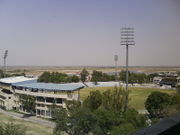
Presently, common sports of Uttar Pradesh are of two distinct genre: the traditional sports and the modern sports of mainly European origin.
Traditional sports, now played mostly as a past time, include wrestling, swimming, kabaddi and track- or water-sports played according to local traditional rules and without use of modern gears; some times, display of martial skills using a sword or ‘Pata’ (stick) etc. form the basis of sports. Due to lack of organized patronage and requisite facilities, these sports are surviving mostly as individuals' hobbies or local competitive events, e.g. in interested schools.
Modern sports – the indoor, field and track games – are popular, especially among the educated class, but the State has yet to attain all-round national standing in most of them. Field hockey is very popular and Uttar Pradesh has produced some of the finest players in India. Dhyan Chand, the legendary field hockey player of India and a hero of many Olympic Games was born on 29 August 1905, in Allahabad, Uttar Pradesh. Adolf Hitler, the Chancellor of Germany, was so impressed by Dhyan Chand's performance in the Berlin Olympic hockey finals that he offered to elevate 'Lance Naik' Dhyan Chand to the rank of a Colonel if he migrated to Germany; Chand had declined the offer.
Cricket has become more popular than field hockey. Though not renowned for it cricket team, U.P. won its first Ranji Trophy tournament in February 2006, beating Bengal in the final. It can also boast of its 3 or 4 players normally finding a place in the national side. Green Park Stadium in Kanpur is one of the oldest cricket venues in India and has witnessed some of India's most famous victories.
Regions of Uttar Pradesh
- Upper Doab
- Middle Doab
- Lower Doab
- Rohilkhand
- Awadh
- Purvanchal
- Bundelkhand
- Baghelkhand
References
- ↑ 1.0 1.1 1.2 "Population estimate". geoHive.com. 2008-07-01. http://www.geohive.com/cntry/india.aspx. Retrieved 2008-08-15.
- ↑ Cahoon, Ben (2000). "Provinces of British India". WorldStatesmen.org. http://www.worldstatesmen.org/India_BrProvinces.htm. Retrieved 2009-09-21.
- ↑ "Governers of Uttar Pradesh". Upgov.nic.in. http://www.upgov.nic.in/upinfo/governers.html. Retrieved 2009-09-21.
- ↑ Ben Cahoon. "Indian states since 1947". Worldstatesmen.org. http://www.worldstatesmen.org/India_states.html. Retrieved 2009-09-21.
- ↑ Virendra N. Misra, Peter Bellwood (1985). Recent Advances in Indo-Pacific Prehistory: proceedings of the international symposium held at Poona, December 19–21, 1978. p. 69. ISBN 9004075127. http://books.google.com/?id=gMoJj-0Z94UC&pg=PA69.
- ↑ Bygone Communities Faced Ire of the River
- ↑ Bridget Allchin, Frank Raymond Allchin (1982). The Rise of Civilization in India and Pakistan. Cambridge University Press. p. 58. ISBN 052128550X. http://books.google.com/?id=r4s-YsP6vcIC&pg=PA58.
- ↑ Hasmukhlal Dhirajlal Sankalia, Shantaram Bhalchandra Deo, Madhukar Keshav Dhavalikar (1985). Studies in Indian Archaeology. Popular Prakashan. p. 96. ISBN 0861320883. http://books.google.com/?id=35DP1Z-2dnYC&pg=PA96.
- ↑ Gibling, M.R.; Sinha, R.; Roy, N.G.; Tandon, S.K.; Jain, M. (2008). "Quaternary fluvial and eolian deposits on the Belan river, India: paleoclimatic setting of Paleolithic to Neolithic archeological sites over the past 85,000 years". Quaternary Science Reviews 27: 391. doi:10.1016/j.quascirev.2007.11.001.
- ↑ Chapter 14 – South Asia: From Early Villages to Buddhism
- ↑ Kenneth A. R. Kennedy (2000). God-apes and Fossil Men. University of Michigan Press. p. 263. ISBN 0472110136. http://books.google.com/?id=W6zQHNavWlsC&pg=PA263.
- ↑ Bridget Allchin, Frank Raymond Allchin (1982). The Rise of Civilization in India and Pakistan. Cambridge University Press. p. 119. ISBN 052128550X. http://books.google.com/?id=r4s-YsP6vcIC&pg=PA119.
- ↑ Prehistoric human colonization of India
- ↑ Krishna Reddy (2003). Indian History. New Delhi: Tata McGraw Hill. p. A11. ISBN 0070483698.
- ↑ M. WItzel, Early Sanskritization. Origins and development of the Kuru State. B. Kölver (ed.), Recht, Staat und Verwaltung im klassischen Indien. The state, the Law, and Administration in Classical India. München : R. Oldenbourg 1997, 27-52
- ↑ "History of Uttar Pradesh – Uttar Pradesh History – History and Origin of Uttar Pradesh India – History of UP". Bharatonline.com. http://www.bharatonline.com/uttar-pradesh/history.html#. Retrieved 2010-07-18.
- ↑ Bandyopādhyāya, Śekhara (2004). From Plassey to Partition: A History of Modern India. Orient Longman. p. 407. ISBN 978-8125025962.
- ↑ Bandyopādhyāya, Śekhara (2004). From Plassey to Partition: A History of Modern India. Orient Longman. p. 406. ISBN 978-8125025962.
- ↑ Akshayakumar Ramanlal Desai Peasant Struggles in India, Oxford University Press, 1979. p. 349.
- ↑ [1]
- ↑ [2]
- ↑ "aegyptica". Bsienvis.nic.in. http://bsienvis.nic.in/medi.htm#Balanites. Retrieved 2009-09-21.
- ↑ "monosperma". Bsienvis.nic.in. http://bsienvis.nic.in/medi.htm#Butea. Retrieved 2009-09-21.
- ↑ "Uttar Pradesh weather". http://www.wunderground.com/NORMS/DisplayIntlNORMS.asp?CityCode=42181&Units=both. Retrieved 2008-09-27.
- ↑ "Census Population" (PDF). Census of India. Ministry of Finance India. http://indiabudget.nic.in/es2006-07/chapt2007/tab97.pdf. Retrieved 2008-12-18.
- ↑ "Census Reference Tables, C-Series Population by religious communities". Census of India. Office of the Registrar General & Census Commissioner, India. 2001. http://www.censusindia.gov.in/Census_Data_2001/Census_data_finder/C_Series/Population_by_religious_communities.htm. Retrieved 2008-07-12.
- ↑ People of India Uttar Pradesh Volume XLII edited by A Hasan & J C Das, Manohar Publications
- ↑ Somini Sengupta (12 May 2007). "Brahmin Vote Helps Party of Low Caste Win in India". The New York Times. http://www.nytimes.com/2007/05/12/world/asia/12india.html?_r=1&oref=slogin. Retrieved 2007-05-12.
- ↑ Rediff news
- ↑ "Banaras hindu university" (PDF). Indian Academy of Sciences. 2005-07-26. http://www.ias.ac.in/currsci/sep102005/899.pdf. Retrieved 2007-04-19.
- ↑ Raj Chengappa (2008-05-22). "India's best colleges: India Today". Indiatoday.intoday.in. http://indiatoday.intoday.in/index.php?option=com_content&Itemid=1&task=view&id=8688§ionid=30&issueid=55&page=archieve. Retrieved 2010-07-18.
- ↑ ITBHU To IIT-BHU
- ↑ "Fast growth trickles up from the states: Ruled by Swaminathan S Anklesaria Aiyar". The Economic Times. 6 January 2010. http://economictimes.indiatimes.com/opinion/columnists/swaminathan-s-a-aiyar/Fast-growth-trickles-up-from-the-states/articleshow/5414772.cms.
- ↑ 34.0 34.1 34.2 Utta Pradesh, October 2007
- ↑ Pradeep Thakur (2008-07-01). "Meerut 9th in top 10 tax-paying cities – India – NEWS – The Times of India". Timesofindia.indiatimes.com. http://timesofindia.indiatimes.com/India/Meerut_9th_in_top_10_tax-paying_cities/articleshow/3182693.cms. Retrieved 2009-09-21.
- ↑ "Three Indian children to attend J8 summit in Rome.:. newkerala.com Online News". Newkerala.com. http://www.newkerala.com/topstory-fullnews-67268.html. Retrieved 2009-09-21.
- ↑ "Uttar Pradesh Legislature". Uplegassembly.nic.in. http://uplegassembly.nic.in/UPLL.HTML. Retrieved 2009-09-21.
- ↑ "Ethnologue report for language code: bfy". Ethnologue.com. http://www.ethnologue.com/show_language.asp?code=bfy. Retrieved 2009-09-21.
- ↑ "A treat of devotional bhajans – Lucknow – City – NEWS – The Times of India". Timesofindia.indiatimes.com. 2001-12-05. http://timesofindia.indiatimes.com/articleshow/549508792.cms. Retrieved 2009-09-21.
- ↑ "18 Popular India Festivals". http://festivals.indobase.com/index.html. Retrieved 2007-12-23.
- ↑ About us Official website. allindiaradio.org. Retrieved:2008-08-03.
- ↑ "A Snapshot of Indian Television History". Indian Television Dot Com Pvt Ltd. http://www.indiantelevision.com/indianbrodcast/history/historyoftele.htm. Retrieved 2006-06-01.
- ↑ Das Gupta, Uma (1977). "The Indian Press 1870–1880: A Small World of Journalism" (see pages 233-234). Modern Asian Studies 11 (2): 213–235. doi:10.1017/S0026749X00015092. http://www.jstor.org/pss/311549.
- ↑ "C. Y. Chintamani (April 10, 1880 — July 1, 1941)". The Tribune. May 7, 2000. http://www.tribuneindia.com/2000/20000507/spectrum/main2.htm#3.
External links
- Uttar Pradesh at the Open Directory Project
- Official website of the Government of Uttar Pradesh
- Official Website of Uttar Pradesh Tourism
- PIN Code Search of All Districts/Post Offices of Uttar Pradesh
 |
Haryana Delhi |
Uttarakhand |  |
|
| Rajasthan | Bihar | |||
| Madhya Pradesh | Jharkhand Chhattisgarh |
|
||||||||||
|
||||||||||||||||||||
|
|||||
